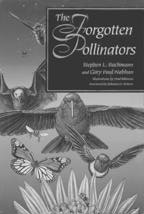Birds Do It; So Do Bees
Reproductive science is sexy stuff in the words of two dedicated naturalists
Reviewed by Christina Waters
A NEWSPAPER article recently recounted the death of more than 900 million South African bees, a massive die-off apparently due to disruption of breeding patterns. Unable to match their feeding schedules with that of plant flowerings, the native honeybees dropped like flies, and fruit crops in the area failed.
To most readers, this sort of lurid statistic may be momentarily startling but probably cuts little emotional ice. For naturalists Stephen L. Buchmann and Gary Paul Nabhan, bee mortality is a bitter fact of life in a shrinking world of fragile ecological networks. Their new book, The Forgotten Pollinators, is an attempt to bring home to a nontechnical audience the intricate and crucial partnerships among flora and their reproductive partners--pollinators--an attempt richly colored by the authors' far-flung field treks and sensuously illustrated by Paul Mirocha.
Injecting their text with dashes of humor and sex appeal, the authors manage to make the dry stuff of reproductive science interesting and touching. It's a detective story that begins 140 million years ago, when flowering plants came to dominance and, lacking their own means of getting around to meet potential sweethearts, began developing complex symbiotic relationships with pollinators who could nurture their genetic messages into the future.
Clear explanations, elegant prose and some case histories as absorbing as prehistoric opera illuminate this text, providing drama, even poignancy, as in Nabhan's account of why flowers evolved into so many forms. "Soon after their Silurian conquest of the ancient land masses more than 400 million years ago, early terrestrial plants took to releasing--almost like dust in the wind--copious quantities of spores," he begins before exploring the co-evolution between pollinators and their lascivious accomplices.
That the underlying message is one of urgency--given the immeasurable loss of habitats, species and eons-old relationships between plants and their pollinators--comes as no surprise. Just as eco-pioneer Rachel Carson warned of the "silent spring" that pesticide poisoning could cause, she also foresaw "fruitless falls," in which "there was no pollination, and there would be no fruit."
Taking this omen as their theme, the authors proceed to riff through the sexual habits of an astonishing menagerie of birds, bees, mammals, dinosaurs, bats, butterflies and botanicals--all endangered and many vanishing as you read this review.
AND SEXY it is. The chapters are filled with sucking, licking, slurping, probing, penetrating, scenting, copulating and caressing. As Nabhan and Buchmann roam the fringes of biology, their own infectious delight in nature's dizzying--though dwindling--diversity, keeps our attention through the book's many technical passages.
In The Forgotten Pollinators, the world is suddenly alive with sexual activity, great clouds of pollen, the scent of aphrodisiac pheromones, the whirr of hummingbird wings. Occasionally the reader must work to keep up, as the scientists lapse into fine distinctions, and sometimes allow technical terms like "extirpation" to go unexplained for several chapters. As much as anything, the book provides an intimate snapshot of working naturalists--collecting, counting, hiking, sweating, marveling--and through their eyes the forge of nature springs to life.
The fascinating web of natural interconnections woven by the authors is so laden with factual exotica that it's worth wading through a few pockets of sci-tech jargon. We learn, for instance, that there are only 30 families of beetles "engaged in the pollination trade" today, out of a whopping 350,000 species of beetles worldwide. Armchair naturalists will delight at the in-depth visits to eco-habitats of unlikely pollinators--lemurs on the island of Madagascar, flying foxes in the Pacific, New Zealand geckos, leaf-nosed bats in Mexico.
The birds and the bees will never look the same again. And if the authors have succeeded, readers will become newly sensitized to the peril of any environmental program that seeks to save endangered habitats, without also insuring the survival of those pollinators who keep the earth flowering and genetically abundant.
[ Metro | Metroactive Central | Archives ]
This page was designed and created by the Boulevards team.

The Forgotten Pollinators
By Stephen L. Buchmann and
Gary Paul Nabhan
Island Press; 320 pages; $25 cloth
From the August 29-September 4, 1996 issue of Metro
Copyright © 1996 Metro Publishing, Inc.
![[Metroactive Books]](/books/gifs/books.gif)